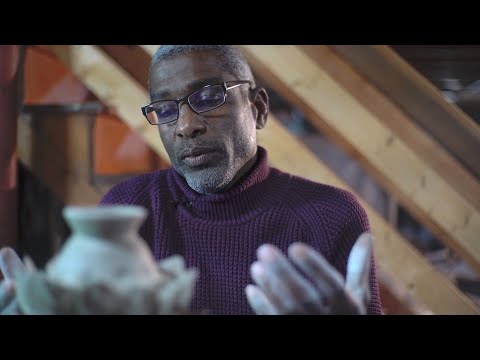Creative Ceramics Artist: Job Description and Salary

Ceramics Artist Job Description Template
Ceramics Artist Job Description A ceramics artist is a skilled professional who works with clay and other materials to create various forms of art, such as sculptures, pottery, and functional ceramics. They use their artistic abilities and technical knowledge to mold, shape, and fire clay into unique and aesthetically pleasing pieces. One of the important aspects of a ceramics artist’s job is to create original designs and concepts for their artwork. They often draw inspiration from nature, culture, and everyday life to develop their ideas. They may also collaborate with clients or other artists to create customized pieces that meet specific requirements. The process of creating ceramics involves several steps, including hand-building, wheel throwing, glazing, and firing. A ceramics artist must have a deep understanding of these techniques and be proficient in working with different types of clay and glazes. They also need to have a good eye for detail and precision to ensure the quality and durability of their finished products. In addition to creating artwork, ceramics artists are responsible for maintaining their tools and equipment, as well as keeping their workspace clean and organized. They may also be involved in marketing and selling their work through exhibitions, galleries, or online platforms. Overall, a ceramics artist requires a combination of artistic talent, technical skills, and creativity to produce unique and visually appealing ceramic pieces. Their work adds beauty and artistic expression to the world of art and design.Ceramics Artist Responsibilities
Ceramics Artist Requirements
How Much Does A Ceramics Artist Make?
Ceramics Artist Salary
| Experience Level | Average Salary |
|---|---|
| Entry Level | $30,000 – $40,000 per year |
| Mid-Level | $40,000 – $60,000 per year |
| Experienced | $60,000 – $80,000 per year |
| Master | $80,000 and above per year |
A ceramics artist’s salary can vary depending on their experience level. Entry-level artists can expect to earn an average salary of $30,000 to $40,000 per year. As they gain more experience and expertise, their salary can increase to $40,000 to $60,000 per year at the mid-level. Experienced ceramics artists, who have established their reputation and skillset, can earn around $60,000 to $80,000 per year. Those who have reached the master level, recognized for their exceptional talent and contributions to the field, can earn $80,000 and above per year. It’s important to note that these salary ranges can also be influenced by factors such as location, demand for ceramics artwork, and individual reputation.
Ceramics Artist Salaries by Country
Top Paying Countries for Ceramics Artists
| Country | Average Salary (USD) |
|---|---|
| United States | 52,000 |
| Germany | 46,000 |
| United Kingdom | 42,000 |
| Canada | 40,000 |
| Australia | 38,000 |
Ceramics artists in the United States earn the highest average salary of $52,000 per year. Germany, the United Kingdom, Canada, and Australia also offer competitive salaries in the ceramics industry, with average annual earnings ranging from $38,000 to $46,000. These countries have a strong market for ceramics art and a thriving arts scene, providing opportunities for artists to earn a good income from their craft. Aspiring ceramics artists may consider these countries as potential destinations to pursue their career and receive better financial rewards for their artistic talent.
A video on the topic Ceramics Artist
Video Source : PenlandSchoolInterview Questions for Ceramics Artist
1. How did you first become interested in ceramics?
I first became interested in ceramics during my high school art class. I was drawn to the tactile nature of the medium and the ability to create functional and decorative objects with my hands.
2. What is your favorite aspect of working with ceramics?
My favorite aspect of working with ceramics is the transformation that occurs during the firing process. It is always exciting to see how the glazes and clay interact and the final result that comes out of the kiln.
3. Can you describe your artistic process when creating a new piece?
When creating a new piece, I usually start with a sketch or idea in mind. Then, I gather the necessary materials and begin shaping the clay. I often experiment with different techniques and glazes to achieve the desired effect.
4. What inspires your designs and motifs?
I draw inspiration from nature, architecture, and different cultures. I love incorporating organic shapes and patterns into my designs, as well as exploring the balance between functionality and aesthetics.
5. How do you choose the colors and glazes for your ceramics?
I choose colors and glazes based on the desired effect and the type of piece I am creating. Sometimes I opt for vibrant and bold colors, while other times I prefer more subtle and earthy tones. I also consider how the glazes will interact with each other during the firing process.
6. What challenges do you face as a ceramics artist?
One of the biggest challenges I face as a ceramics artist is the unpredictability of the medium. Sometimes pieces can crack or warp during the firing process, and it can be frustrating when a piece doesn’t turn out as expected. Additionally, ceramics requires a lot of patience and attention to detail.
7. How do you incorporate functionality into your ceramic pieces?
I believe that functionality is an important aspect of ceramics. I strive to create pieces that can be used and enjoyed in everyday life, such as bowls, mugs, and vases. I pay attention to the ergonomics and usability of each piece to ensure they are not only visually appealing but also practical.
8. Can you tell us about a particularly memorable project or commission you have worked on?
One particularly memorable project I worked on was a commissioned installation for a local restaurant. I created a series of ceramic tiles with intricate designs that were installed on the restaurant’s walls. It was a challenging yet rewarding project, and seeing my work as a permanent part of the restaurant’s interior was incredibly fulfilling.
9. How do you continue to develop and evolve as a ceramics artist?
I continue to develop and evolve as a ceramics artist by attending workshops and classes to learn new techniques and explore different styles. I also find inspiration in other artists’ work and constantly push myself to try new ideas and experiment with different forms and glazes.
10. What advice do you have for aspiring ceramics artists?
My advice for aspiring ceramics artists is to practice and experiment as much as possible. Don’t be afraid to make mistakes, as they can often lead to new discoveries. Also, be patient and persistent, as ceramics is a craft that requires time and dedication to master.






